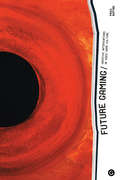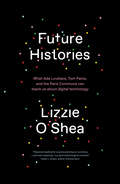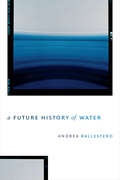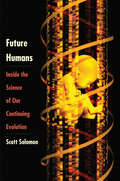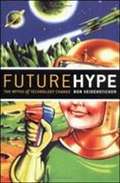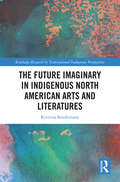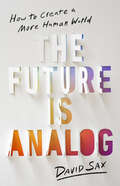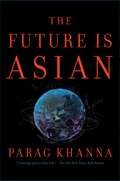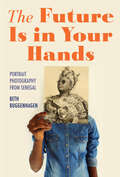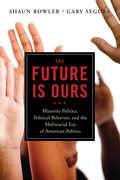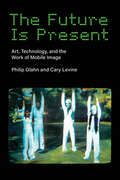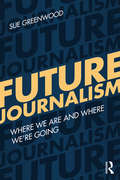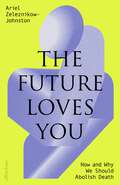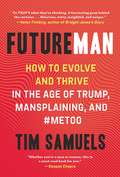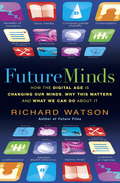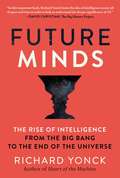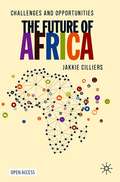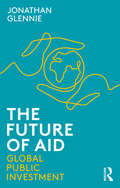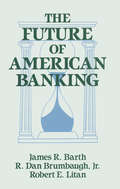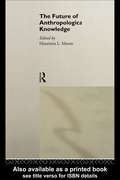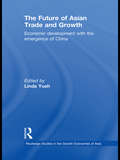- Table View
- List View
Future Gaming: Creative Interventions in Video Game Culture (Goldsmiths Press / Future Media Series)
by Paolo RuffinoA sophisticated critical take on contemporary game culture that reconsiders the boundaries between gamers and games.This book is not about the future of video games. It is not an attempt to predict the moods of the market, the changing profile of gamers, the benevolence or malevolence of the medium. This book is about those predictions. It is about the ways in which the past, present, and future notions of games are narrated and negotiated by a small group of producers, journalists, and gamers, and about how invested these narrators are in telling the story of tomorrow.This new title from Goldsmiths Press by Paolo Ruffino suggests the story could be told another way. Considering game culture, from the gamification of self-improvement to GamerGate's sexism and violence, Ruffino lays out an alternative, creative mode of thinking about the medium: a sophisticated critical take that blurs the distinctions among studying, playing, making, and living with video games. Offering a series of stories that provide alternative narratives of digital gaming, Ruffino aims to encourage all of us who study and play (with) games to raise ethical questions, both about our own role in shaping the objects of research, and about our involvement in the discourses we produce as gamers and scholars. For researchers and students seeking a fresh approach to game studies, and for anyone with an interest in breaking open the current locked-box discourse, Future Gaming offers a radical lens with which to view the future.
Future Girl: Young Women in the Twenty-First Century
by Anita HarrisAnita Harris creates a realistic portrait of the "new girl" that has appeared in the twenty-first century--she may still play with Barbie, but she is also likely to play soccer or basketball, be assertive and may even be sexually aware, if not active. Building on this new definition, Harris explores the many key areas central to the lives of girls from a global perspective, such as girlspace, schools, work, aggression, sexuality and power.
Future Histories: What Ada Lovelace, Tom Paine, and the Paris Commune Can Teach Us About Digital Technology
by Lizzie O'SheaA highly engaging tour through progressive history in the service of emancipating our digital tomorrow.When we talk about technology we always talk about tomorrow and the future -- which makes it hard to figure out how to even get there. In Future Histories, public interest lawyer and digital specialist Lizzie O'Shea argues that we need to stop looking forward and start looking backwards. Weaving together histories of computing and progressive social movements with modern theories of the mind, society, and self, O'Shea constructs a "usable past" that can help us determine our digital future.What, she asks, can the Paris Commune tell us about earlier experiments in sharing resources--like the Internet--in common? How can Frantz Fanon's theories of anti colonial self-determination help us build digital world in which everyone can participate equally? Can debates over equal digital access be helped by American revolutionary Tom Paine's theories of democratic, economic redistribution? What can indigenous land struggles teach us about stewarding our digital climate? And, how is Elon Musk not a future visionary but a steampunk throwback to Victorian-era technological utopians?In engaging, sparkling prose, O'Shea shows us how very human our understanding of technology is, and how when we draw on the resources of the past, we can see the potential for struggle, for liberation, for art and poetry in our technological present. Future Histories is for all of us--makers, coders, hacktivists, Facebook-users, self-styled Luddites--who find ourselves in a brave new world.
A Future History of Water
by Andrea BallesteroBased on fieldwork among state officials, NGOs, politicians, and activists in Costa Rica and Brazil, A Future History of Water traces the unspectacular work necessary to make water access a human right and a human right something different from a commodity. Andrea Ballestero shows how these ephemeral distinctions are made through four technolegal devices—formula, index, list and pact. She argues that what is at stake in these devices is not the making of a distinct future but what counts as the future in the first place. A Future History of Water is an ethnographically rich and conceptually charged journey into ant-filled water meters, fantastical water taxonomies, promises captured on slips of paper, and statistical maneuvers that dissolve the human of human rights. Ultimately, Ballestero demonstrates what happens when instead of trying to fix its meaning, we make water’s changing form the precondition of our analyses.
Future Humans: Inside the Science of Our Continuing Evolution
by Scott SolomonAn evolutionary biologist provides surprising insights into the changing nature of Homo sapiens in this &“important and an entertaining read" (Choice). In Future Humans, evolutionary biologist Scott Solomon draws on recent discoveries to examine the future evolution of our species. Combining knowledge of our past with current trends, Solomon offers convincing evidence that evolutionary forces are still affecting us today. But how will modernization—including longer lifespans, changing diets, global travel, and widespread use of medicine and contraceptives—affect our evolutionary future? Solomon presents an entertaining and accessible review of the latest research on human evolution in modern times, drawing on fields from genomics to medicine and the study of our microbiome. Drawing together topics ranging from the rise of online dating and Cesarean sections to the spread of diseases such as HIV and Ebola, Solomon suggests that we are entering a new phase in human evolutionary history—one that makes the future less predictable and more interesting than ever before.
Future Hype: The Myths of Technology Change
by Bob SeidenstickerConventional wisdom says that technology is the greatest new growth frontier, coupling infinite potential with an ever-growing number of faster, more efficient, and more reliable products and instruments.According to this view, we live in an unprecedented golden age of technological expansion. Not so, according to Future Hype.
The Future Imaginary in Indigenous North American Arts and Literatures (Routledge Research in Transnational Indigenous Perspectives)
by Kristina BaudemannThis book examines the future in Indigenous North American speculative literature and digital arts. Asking how different Indigenous works imagine the future and how they negotiate settler colonial visions of what is to come, the chapters illustrate that the future is not an immutable entity but a malleable textual/digital product that can function as both a colonial tool and a catalyst for decolonization. Central to this study is the development of a methodology that helps unearth the signifying structures producing the future in selected works by Darcie Little Badger, Gerald Vizenor, Stephen Graham Jones, Skawennati, Danis Goulet, Scott Benesiinaabandan, Postcommodity, Kite, Jeff Barnaby, and Ryan Singer. Drawing on Jason Lewis’s "future imaginary" as the theoretical core, the book describes the various forms of textual representation and virtual simulation through which notions of Indigenous continuation are expressed in literary and new media works. Arguing that Indigenous authors and artists apply the aesthetics of the future as a strategy in their works, the volume conceptualizes its multimedia corpus as a continuously growing archive of, and for, Indigenous futures.
The Future in Minutes (In Minutes)
by Keith MansfieldWHAT DOES THE FUTURE HOLD?200 FUTURISTIC CONCEPTS, TECHNOLOGIES, AND THEIR CONSEQUENCES, EXPLAINED IN AN INSTANTHow will we live, work, and entertain ourselves? What new technologies will emerge? Will humanity evolve--and perhaps live forever? Or are we facing threats that could end us--and even the whole universe?The Future in Minutes tackles these and many other fundamental questions, concisely and lucidly explaining everything from crypto currencies and world governments to gene therapy and colonizing planets--and painting our options for utopia or disaster. Contents include: Predicting the Future; How We'll Live; Shifts in Society; Technology of the Future; Scarcity and Solutions; Politics, Warfare, and Ethics; The Quest for Immortality; Transhumans and Posthumans; Artificial Intelligence; Threats to Humanity; Space Travel and Colonization; Super-Advanced Science; and The Fate of the Earth and the Universe.
The Future Is Analog: How to Create a More Human World
by David SaxBestselling culture writer David Sax lays out the case against a false digital utopia—and for a more human future In The Future Is Analog, David Sax points out that the onset of the pandemic instantly gave us the digital universe we&’d spent so long anticipating. Instant communication, online shopping, virtual everything. It didn&’t take long to realize how awful it was to live in this promised future. We craved real experiences, relationships, and spaces and got back to real life as quickly and often as we could. In chapters exploring work, school, religion, and more, this book asks pointed questions: Is our future inevitably digital? Can we reject the downsides of digital technology without rejecting change? Can we innovate not for the sake of productivity but for the good of our social and cultural lives? Can we build a future that serves us as humans, first and foremost? This is a manifesto for a different kind of change. We can spend our creativity and money on building new gadgets—or we can spend them on new ways to be together and experience the world, to bake bread, and climb mountains. All we need is the clarity to choose which future we want.
The Future Is Asian: Commerce, Conflict And Culture In The 21st Century
by Parag KhannaIn the 19th century, the world was Europeanized. In the 20th century, it was Americanized. Now, in the 21st century, the world is being Asianized.The “Asian Century” is even bigger than you think. Far greater than just China, the new Asian system taking shape is a multi-civilizational order spanning Saudi Arabia to Japan, Russia to Australia, Turkey to Indonesia—linking five billion people through trade, finance, infrastructure, and diplomatic networks that together represent 40 percent of global GDP. China has taken a lead in building the new Silk Roads across Asia, but it will not lead it alone. Rather, Asia is rapidly returning to the centuries-old patterns of commerce, conflict, and cultural exchange that thrived long before European colonialism and American dominance. Asians will determine their own future—and as they collectively assert their interests around the world, they will determine ours as well. There is no more important region of the world for us to better understand than Asia – and thus we cannot afford to keep getting Asia so wrong. Asia’s complexity has led to common misdiagnoses: Western thinking on Asia conflates the entire region with China, predicts imminent World War III around every corner, and regularly forecasts debt-driven collapse for the region’s major economies. But in reality, the region is experiencing a confident new wave of growth led by younger societies from India to the Philippines, nationalist leaders have put aside territorial disputes in favor of integration, and today’s infrastructure investments are the platform for the next generation of digital innovation. If the nineteenth century featured the Europeanization of the world, and the twentieth century its Americanization, then the twenty-first century is the time of Asianization. From investment portfolios and trade wars to Hollywood movies and university admissions, no aspect of life is immune from Asianization. With America’s tech sector dependent on Asian talent and politicians praising Asia’s glittering cities and efficient governments, Asia is permanently in our nation’s consciousness. We know this will be the Asian century. Now we finally have an accurate picture of what it will look like.
The Future Is in Your Hands: Portrait Photography from Senegal (Material Vernaculars)
by Beth BuggenhagenIn Senegal, portraiture serves as a vital index and creator of social connection. People sit for and display portraits, keep albums, and view illustrated magazines together. Through these portraiture practices, Senegalese have fashioned idealized images to mend fraught and fragmented lives in the context of decades of migration. The Future Is in Your Hands provides an expansive frame for photography to highlight the role of affect in portraiture practices. Moving from the colonial to the newly independent Senegal, Beth Buggenhagen combines museum, ethnographic, and archival research on photography's past with lens-based artists who address themes of separation, visibility, rupture, and repatriation through portraiture. Buggenhagen, in collaboration with Senegalese photographers, explores how photographs, as visual and material objects, migrate themselves and, like the bodies they represent, create a record not only of lived experiences but also of the cycle of migration for this labor-exporting country.By complicating the history of portraiture in Senegal, The Future Is in Your Hands reveals the enduring power of images and the efforts under way to keep this art form safely in Senegalese hands.
The Future Is Ours: Minority Politics, Political Behavior, and the Multiracial Era of American Politics
by Dr Shaun Bowler Gary M. SeguraToday's demographic reality is a "majority-minority" America wherein racial and ethnic minorities comprise a growing share of the U.S. population and electorate, and are themselves becoming more diverse and representing more decisive votes. How America evolves as a society and a polity depends on whether and how these new Americans access and are accommodated by existing institutions. The Future is Ours offers a data-based examination of whether (and exactly how) minority citizens differ from members of the white majority—in political participation, voting preferences, policy opinions, orientations toward government, and legislative representation. Data analyses are presented in non-technical fashion, but throughout the authors attempt to engage issues of research design that expose students to the logics of social science inquiry. Bowler and Segura argue that demography will, in fact, be destiny. The balance between the two parties is at a tipping point and the outcome depends on how minority Americans engage in politics.
The Future Is Present: Art, Technology, and the Work of Mobile Image (Leonardo)
by Cary Levine Philip GlahnA critical history of the pioneering art and technology group Mobile Image and their prescient work in communications, networking, and information systems.In The Future Is Present, Philip Glahn and Cary Levine tell the fascinating history of the visionary art group Mobile Image—founded by Kit Galloway and Sherrie Rabinowitz in 1977—which appropriated emerging technologies, from satellites to electronic message platforms. Based in Los Angeles, this under-studied collective worked amid urban crisis, a techno-boom, consolidating media power, and ascendant neoliberal politics. Mobile Image challenged fundamental conventions of the public sphere, democracy, communication, and political participation, as well as notions of power, representation, and identity.Glahn and Levine argue not only for the historical importance of Mobile Image, but also for a critical artistic process that is at once analytic and transformative. They weave themes such as embodiment and its mediation, public/private dialectics, and techno-utopian vision throughout the book, binding these projects to discourses around race, gender, and class, as well as margin and center, the local and the global. In today&’s world of ubiquitous digital re/production, networking, and social media, The Future Is Present shows how the work of Mobile Image continues to have profound implications for art, technology, and the politics of public and private experience.
Future Journalism: Where We Are and Where We’re Going
by Sue GreenwoodFuture Journalism investigates where journalism has come from, where it is now and where it might be going, through a range of case studies on organisations pushing the traditional boundaries of journalism, including Vice, Buzzfeed, Bellingcat, The Washington Post, the Guardian, Circa and Narrative Science. Sue Greenwood presents an analysis of the significant trends and practices shaping contemporary journalism and investigates what they can tell us about possible new directions for the news industry in the future. Chapters explore: the rise of new business models for digital news production and their future; debates around the potential for non-human "journalists"; the fluctuating figures around news consumption by audiences and what they can mean; the growing importance of ethical journalism in the digital age; practical exercises and recommended further reading. In a constantly evolving media environment, this book guides readers through some of the most vital contemporary debates and important technological developments. It is essential reading for students and young professionals preparing for a future in the journalism industry.
The Future Loves You: How and Why We Should Abolish Death
by Dr Ariel Zeleznikow-JohnstonA brilliant young neuroscientist explains how to preserve our minds indefinitely, enabling future generations to choose to revive usJust as surgeons once believed pain was good for their patients, some argue today that death brings meaning to life. But given humans rarely live beyond a century – even while certain whales can thrive for over two hundred years – it’s hard not to see our biological limits as profoundly unfair. No wonder then that most people nearing death wish they still had more time.Yet, with ever-advancing science, will the ends of our lives always loom so close? For from ventilators to brain implants, modern medicine has been blurring what it means to die. In a lucid synthesis of current neuroscientific thinking, Zeleznikow-Johnston explains that death is no longer the loss of heartbeat or breath, but of personal identity – that the core of our identities is our minds, and that our minds are encoded in the structure of our brains. On this basis, he explores how recently invented brain preservation techniques now offer us all the chance of preserving our minds to enable our future revival.Whether they fought for justice or cured diseases, we are grateful to those of our ancestors who helped craft a kinder world – yet they cannot enjoy the fruits of the civilization they helped build. But if we work together to create a better future for our own descendants, we may even have the chance to live in it. Because, should we succeed, then just maybe, the future will love us enough to bring us back and share their world with us.
Future Man: How to Evolve and Thrive in the Age of Trump, Mansplaining, and #MeToo
by Tim SamuelsA sharply intelligent, explosively honest, and laugh-out-loud funny look at the state of masculinity and how to be a man, for fans of Jon Ronson and Matt Haig.If ever there was an urgent need for a frank understanding of what's going on with men, it is now. Male rage and frustration have driven resurgent populism, mass shootings, and epidemics of addiction and violence. Powerful men who have abused their positions for decades have been and are being #MeToo–outed and dismissed. The patriarchy, that solid bedrock of male power for thousands of years, seems to be crumbling.In Future Man, with his characteristic intelligence and humor, Tim Samuels assesses the state of contemporary manhood, its conflicts, confusions, and challenges. Trapped in bodies barely changed since cavemen days, men are contending with the stresses of corporate culture, lifelong commitment, rampant depression, and crazy expectations to be successful at work and at home. But how can you hunt and gather in an open-plan office? Why do men make up to 95 percent of Fortune 500 CEOs yet 93 percent of the prison population? Why do men commit suicide at more than three times the rate of women?Drawing on his own experience and reporting, Samuels addresses such topics as dating, aging, fatherhood, porn, violence, mental health, and the trouble with monogamy as well as issues related to toxic masculinity, the man box, gender roles, and role models. The American edition has been updated and includes a new preface.
Future Minds: How the Digital Age Is Changing Our Minds, Why This Matters, and What We Can Do About It
by Richard WatsonDrawing on the latest research, this book looks at the ways that screen culture is shaping the future and changing the way we think. Future Minds asks: are we becoming addicted to data and how do we go about starting a digital diet, urgently? You'll find thought-provoking and practical suggestions about reclaiming the space and time to think deeply.
Future Minds
by Richard WatsonDrawing on the latest research, this book looks at the ways that screen culture is shaping the future and changing the way we think. Future Minds asks: are we becoming addicted to data and how do we go about starting a digital diet, urgently? You'll find thought-provoking and practical suggestions about reclaiming the space and time to think deeply.
Future Minds: The Rise of Intelligence from the Big Bang to the End of the Universe
by Richard YonckFor Readers of Michio Kaku and Stephen Hawking, an Epic Journey through the Intelligent Universe With the ongoing advancement of AI and other technologies, our world is becoming increasingly intelligent. From chatbots to innovations in brain-computer interfaces to the possibility of superintelligences leading to the Singularity later this century, our reality is being transformed before our eyes. This is commonly seen as the natural result of progress, but what if there&’s more to it than that? What if intelligence is an inevitability, an underlying property of the universe? In Future Minds, Richard Yonck challenges our assumptions about intelligence—what it is, how it came to exist, its place in the development of life on Earth and possibly throughout the cosmos. Taking a Big History perspective—over the 14 billion years from the Big Bang to the present and beyond—he draws on recent developments in physics and complexity theory to explore the questions: Why do pockets of increased complexity develop, giving rise to life, intelligence, and civilization? How will it grow and change throughout this century, transforming both technology and humanity? As we expand outward from our planet, will we discover other forms of intelligence, or will we conclude we are destined to go it alone? Any way we look at it, the nature of intelligence in the universe is becoming a central concern for humanity. Ours. Theirs. And everything in between.
The Future of Africa: Challenges and Opportunities
by Jakkie CilliersThis open access textbook offers a critical introduction to human and economic development prospects in Africa revolving around three questions: where is Africa today, what explains the current state, and, given historical trends and what we know about the world, where do we think the continent will be in 2040? And, a final question: what can we do to create a better tomorrow? It models ambitious progress in health, demographics, agriculture, education, industrialization, technological leapfrogging, increased trade, greater stability, better governance and external support. The book reviews the future of work/jobs, poverty and the impact of climate change. A combined Closing the Gap scenario presents a forecast of what could be possible by 2040. Each chapter suggests which policies might accelerate prospects for each sector. Written in an accessible style, and supported by a range of pedagogical features, this textbook introduces undergraduate and graduate students to the contemporary human and economic development prospects in Africa.
The Future of Aid: Global Public Investment
by Jonathan GlennieInternational cooperation has never been more needed, but the current system of “aid” is outdated and ineffective. The Future of Aid calls for a wholesale restructuring of the aid project, a totally new approach fit for the challenges of the 21st century: Global Public Investment. Across the world, billions of people are struggling to get by in unequal and unsustainable societies, and international public finance, which should be part of the answer, is woefully deficient. Engagingly written by a well-known expert in the field, The Future of Aid calls for a series of paradigm shifts. From a narrow focus on poverty to a broader attack on inequality and sustainability. From seeing international public money as a temporary last resort, to valuing it as a permanent force for good. From North-South transfers to a collective effort, with all paying in and all benefitting. From outdated post-colonial institutions to representative decision-making. From the othering and patronising language of “foreign aid”, to the empowering concept of Global Public Investment. Ten years ago, in The Trouble with Aid, Jonathan Glennie highlighted the dangers of aid dependency and the importance of looking beyond aid. Now he calls for a revolution in the way that we think about the role of public money to back up our ambitious global objectives. In the wake of the COVID-19 crisis, it is time for a new era of internationalism.
The Future of American Banking (Columbia University Seminars Ser.)
by James R. Barth Robert E. Litan R.Dan BrumbaughThe future of American banking is in doubt and the industry and the federal insurance fund that helps support it are in turmoil. The ingredients of the turmoil have been simmering in public view since at least the early 1980s when commercial bank loans to lesser developed countries (LDCs) began to default. The difficulties began to boil at the end of the decade when the prospect first arose that the banks' deposit insurer, the Bank Insurance Fund (BIF) that is administered by the Federal Deposit Insurance Corporation (FDIC), might require dollars to resolve bank failure as occurred in the savings and loan debacle. This book frames the major economic and policy issues raised by the banking crisis whose resolution largely determines the future of American banking. It focuses on the current reported condition of the banking industry, concentrating on large banks in particular. A longer-run economic prognosis for the banking industry is presented and the implications of future bank failures for the financial services sector and federal regulatory policy are discussed. Most importantly the book contains suggestions for changes in the nation's deposit-insurance system and accompanying banking laws. These changes would reduce the federal government's deposit insurance liability and would provide banks with potentially profitable opportunities. The study includes a wealth of data on the financial condition of American banks and the system as a whole, some of it not easily obtainable from any other source. The authors are internationally recognized as knowledgeable experts on the state of the American banking system and the options and prospects for US banking reform.
The Future of Anthropological Knowledge (ASA Decennial Conference Series: The Uses of Knowledge)
by Henrietta L. MooreThe Future of Anthropological Knowledge the chapters explore the question of the nature of social knowledge from a variety of perspectives and locations such as China, Africa, the USA and elsewhere. By examining the changing nature of anthropological knowledge and of the production of that knowledge, this book challenges the notion that only western societies have produced social theories of modernity and of global scope. Knowledge of society can no longer be restricted to a knowledge of face-to-face social relations but must encompass the effect of technology, global consumption patterns and changing geo-political configurations. The Future of Anthropological Knowledge will be of interest to anthropologists and students of culture and society.
The Future of Architecture in 100 Buildings
by Marc KushnerPart of the TED series: The Future of Architecture in 100 BuildingsA pavilion made from paper. An inflatable concert hall. A building that eats smog. A bridge that grows grapes. The Future of Architecture in 100 Buildings captures the soaring confidence, the thoughtful intelligence, the futuristic wonder, and at times the sheer whimsy of the world's most inspired and future-looking buildings. As author Marc Kushner explains, 'The future of architecture is not one of any dominant style, but rather a world of constant innovation and experimentation.' Like an architectural cabinet of wonders, the book captures this glorious global diversity. From soaring steel towers to bamboo bungalows; from iconic monuments to ingenious children's playgrounds, each page offers an unexpected glimpse of architecture's potential. Through his book and TEDTalk, Kushner suggests that in the age of social media, buildings speak louder than ever. Everyone with a smartphone has become an architectural photographer, snapping selfies with the world's most photogenic buildings. And this constant stream of photos ensures that architecture is now in conversation with the world. Its future matters more - and to more of us - than ever. Aimed at this new, broad audience for architecture, this is an essential and delightful guide to the future being built around us.
The Future of Asian Trade and Growth: Economic Development with the Emergence of China (Routledge Studies in the Growth Economies of Asia)
by Linda YuehThis book presents a comprehensive analysis of current trends of trade and economic growth in Asia, assessing how they are likely to develop in the future. It examines the evolving patterns of Asian economic development with the emergence of China, including since China’s accession to the World Trade Organisation (WTO) in 2001. It is written by experts specialising in economic growth and regional and global trade/investment issues, alongside country specialists who have examined the development path of Asian economies. It discusses the significance of a export-oriented growth strategy on the Asian region, and the likely patterns of intra-regional specialisation given China’s rise. The book examines the degree to which the remarkable growth of China is likely to affect other Asian countries in terms of global market share, and growth prospects. The book explores how the rise of intra-industry trade is affecting patterns of specialisation in the region, and appraises the role of multinational corporations and foreign direct investment. Informed by the latest empirical economic thinking, this book is a rigorous examination of the influence of an emerging economic superpower, and the future for economic growth in Asia. Readers interested in the implications of the rise of China, the effect on the economic development path of the most successful developing nations of our time and the lessons to be heeded from China’s integration with the global economy will find this a thorough yet accessible account of the influence of an emerging economic superpower.
